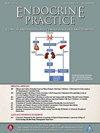活性棕色脂肪组织在嗜铬细胞瘤或副神经节瘤(PPGL)患者中的作用。
IF 3.7
3区 医学
Q2 ENDOCRINOLOGY & METABOLISM
引用次数: 0
摘要
目的:代谢活跃的棕色脂肪组织(aBAT)是嗜铬细胞瘤或副神经节瘤(PPGL)患者 18FDG-PET 成像的常见发现。除了其临床意义外,我们还旨在探讨这一发现在 PPGL 患者的 FDG-PET 成像中的流行程度:我们对前瞻性和回顾性研究进行了系统回顾和荟萃分析。通过检索 MEDLINE/PubMed、Embase 和 SCOPUS,确定了从开始到 2022-11-26 期间的文献,并于 2024-05-02 进行了更新检查。符合条件的研究包括已完成 FDG-PET 成像的 PPGL 患者。我们采用随机效应模型和反方差法提取了儿茶酚胺水平数据,并根据是否存在 aBAT 进行了分层。在定量综合方面,我们采用了标准化均值差异(SMD)和比例荟萃分析法。使用 QUIPS 工具进行了偏倚风险评估:搜索结果显示有 6 项研究适合纳入。汇总数据显示,与 aBAT 阴性组相比,aBAT 阳性组的分离去甲基儿茶酚胺水平存在统计学意义上的显著正差异。在肿瘤大小、肿瘤负荷、种系突变或位置等多个方面均未发现明显差异。PPGL患者中出现aBAT的比例约为25%:去甲基化代谢物水平可用于预测PPGL患者体内是否存在活跃的棕色脂肪组织。没有令人信服的证据表明 PPGL 和种系突变患者的 aBAT 患病率增加。但有证据表明,aBAT的存在可能会导致较差的预后和预期寿命的缩短。本文章由计算机程序翻译,如有差异,请以英文原文为准。
The Role of Active Brown Adipose Tissue in Patients With Pheochromocytoma or Paraganglioma
Objectives
Metabolically-active brown adipose tissue (aBAT) is a common finding on 18fluorodeoxyglucose positron emission tomography (FDG-PET) imaging in patients with pheochromocytoma or paraganglioma (PPGL). In addition to its clinical significance, we aimed to explore the prevalence of this finding on FDG-PET imaging in patients with PPGL.
Methods
We conducted a systematic review and meta-analysis of prospective and retrospective studies. Publications were identified through searches in MEDLINE/PubMed, Embase, and SCOPUS from inception until 2022-11-26, with an update check performed on 2024-05-02. Eligible studies included patients with PPGL who had completed FDG-PET imaging. Data on catecholamine levels stratified by the presence of aBAT were extracted and pooled using the random-effects model with the inverse variance method. For the quantitative synthesis, we used standardized mean differences and meta-analysis of proportions. A risk of bias assessment was performed using the Quality in Prognostic Studies tool.
Results
Our search yielded 6 studies suitable for inclusion. Pooled data showed a statistically significant positive difference in isolated demethylated catecholamine levels in aBAT positive groups compared to aBAT negative. No significant differences were found in multiple domains, including tumor size, tumor burden, germline mutations, or location. The proportion of patients with PPGL who present with aBAT stands at approximately 25%.
Conclusions
The demethylated metabolite levels could have potential use in predicting the presence of active brown adipose tissue in patients with PPGL. There is no convincing evidence of increased aBAT prevalence in patients with PPGL and germline mutations. There was, however, evidence suggesting that the presence of aBAT may confer poorer outcomes and decreased life expectancy.
求助全文
通过发布文献求助,成功后即可免费获取论文全文。
去求助
来源期刊

Endocrine Practice
ENDOCRINOLOGY & METABOLISM-
CiteScore
7.60
自引率
2.40%
发文量
546
审稿时长
41 days
期刊介绍:
Endocrine Practice (ISSN: 1530-891X), a peer-reviewed journal published twelve times a year, is the official journal of the American Association of Clinical Endocrinologists (AACE). The primary mission of Endocrine Practice is to enhance the health care of patients with endocrine diseases through continuing education of practicing endocrinologists.
 求助内容:
求助内容: 应助结果提醒方式:
应助结果提醒方式:


